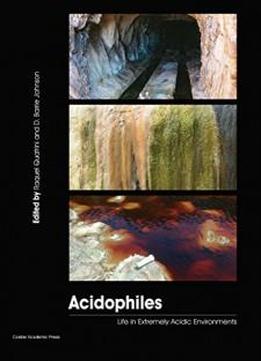
Acidophiles: Life In Extremely Acidic Environments
by D. Barrie Johnson /
2016 / English / PDF
12 MB Download
Acidophiles are life-forms that grow preferentially in natural or
man-made environments where the pH is well below seven. Together
with other categories of extremophiles, they have greatly expanded
our knowledge of the diversity of life, our understanding on how
microorganisms can adapt to seemingly hostile situations, and
provided scenarios for the possibility that life-forms may be found
outside of our solar system. Written by experts in their field,
this important volume provides a comprehensive account of
acidophilic microbiology from fundamental to applied aspects. The
seventeen chapters are arranged in five sections, each dealing with
a specific area. The first section looks at the challenges faced by
life-forms that grow in extremely acidic environments and how they
adapt to meet these challenges. The next section describes the
physiological and phylogenetic diversities of acidophilic
microorganisms including archaea, bacteria and eukaryotes. Section
three covers acidophile community dynamics, quorum sensing and the
formation of biofilms. The next section deals with the various omic
technologies that are used to study acidophiles including genomic
and metagenomic studies, proteomic-, mobilomic- and
metabolomic-focused research. The final section considers the ways
in which acidophiles are used in established and emerging
biotechnologies and describes why these fascinating microorganisms
are considered potential candidates for life on other solar bodies,
such as Mars, and beyond. This up-to-date and comprehensive book
will be indispensable for environmental scientists and
microbiologists and is a recommended acquisition for all
microbiology libraries.
Acidophiles are life-forms that grow preferentially in natural or
man-made environments where the pH is well below seven. Together
with other categories of extremophiles, they have greatly expanded
our knowledge of the diversity of life, our understanding on how
microorganisms can adapt to seemingly hostile situations, and
provided scenarios for the possibility that life-forms may be found
outside of our solar system. Written by experts in their field,
this important volume provides a comprehensive account of
acidophilic microbiology from fundamental to applied aspects. The
seventeen chapters are arranged in five sections, each dealing with
a specific area. The first section looks at the challenges faced by
life-forms that grow in extremely acidic environments and how they
adapt to meet these challenges. The next section describes the
physiological and phylogenetic diversities of acidophilic
microorganisms including archaea, bacteria and eukaryotes. Section
three covers acidophile community dynamics, quorum sensing and the
formation of biofilms. The next section deals with the various omic
technologies that are used to study acidophiles including genomic
and metagenomic studies, proteomic-, mobilomic- and
metabolomic-focused research. The final section considers the ways
in which acidophiles are used in established and emerging
biotechnologies and describes why these fascinating microorganisms
are considered potential candidates for life on other solar bodies,
such as Mars, and beyond. This up-to-date and comprehensive book
will be indispensable for environmental scientists and
microbiologists and is a recommended acquisition for all
microbiology libraries.











